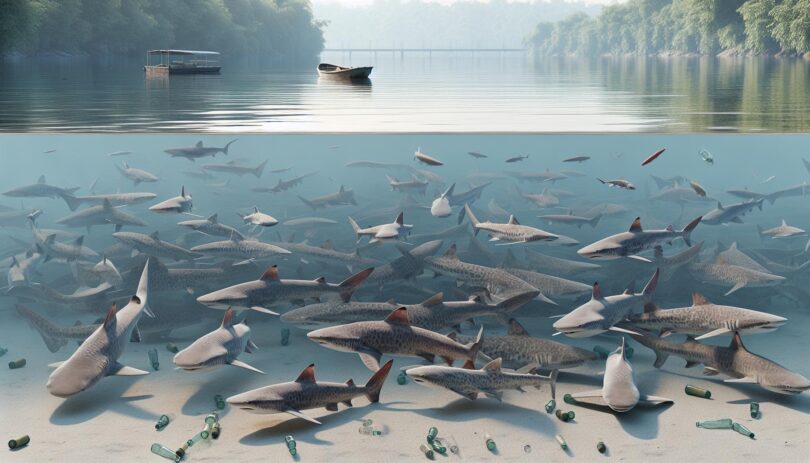Freshwater sharks sound like something straight out of a fantasy book, don’t they? But believe it or not, these intriguing creatures are as real as the water they swim in. I’ve always been fascinated by the adaptability of wildlife, and freshwater sharks are a prime example of nature’s ingenuity.
Swimming through rivers and lakes, these sharks have adapted to environments far removed from the salty oceans we usually associate them with. They’re not your typical Jaws-type predators, but their presence in freshwater habitats is equally captivating. Join me as we dive into the world of freshwater sharks, exploring their habitats, species, and the incredible ways they’ve adapted to thrive in environments you wouldn’t expect to find them in.
Habitat of Freshwater Sharks
In my journey to uncover the mysteries of freshwater sharks, I’ve delved into the diverse habitats these remarkable creatures call home. Contrary to popular belief that sharks are solely marine animals, certain species have mastered the ability to thrive in freshwater environments. This adaptability showcases their evolutionary prowess and allows them to inhabit areas most wouldn’t expect to find them.
Rivers and Lakes: Some of the most well-known freshwater sharks make rivers and lakes their hunting grounds. The Bull Shark, for example, can navigate both salt and freshwater and is notorious for its presence in the Amazon River as well as Lake Nicaragua. These areas offer a bountiful supply of prey and have less saline water, which is crucial for the osmoregulation process in these sharks.
Estuaries and Delta Regions: These transitional zones between river environments and marine ecosystems serve as nurseries for certain shark species. The young sharks find refuge in the less saline, nutrient-rich waters of estuaries and deltas, growing and preparing for their eventual journey into the open sea. This period in freshwater environments plays a critical role in their development and survival.
Migration Patterns: Interestingly, some freshwater sharks exhibit migratory behaviors, moving between freshwater and marine environments throughout different stages of their lives. This migration is often linked to breeding, feeding, or lifecycle events, illustrating the complex relationship these sharks have with their habitats.
Adaptable Living Conditions: The ability to adjust to varying salinity levels is a testament to the biological marvel of freshwater sharks. Their presence in freshwater environments challenges our understanding of shark habitats and opens new avenues for research into their survival mechanisms.
Exploring the habitats of freshwater sharks reveals a tapestry of ecosystems ranging from murky rivers to sprawling lakes. Each environment plays a pivotal role in the life cycle of these sharks, offering insights into the adaptability and resilience of wildlife in the face of environmental challenges.
Different Species of Freshwater Sharks

In my ongoing exploration of freshwater sharks, it’s crucial to spotlight the diverse species that have adapted to life away from the open seas. Among these fascinating creatures, a few stand out for their unique characteristics and environments.
Firstly, the Bull Shark is perhaps the most renowned for its freshwater ventures. Unlike many of its kin, Bull Sharks possess the remarkable ability to regulate their salt and water balance, allowing them to migrate between saltwater and freshwater with ease. They’re frequently spotted in the Amazon River and Lake Nicaragua, showcasing their incredible adaptability.
Another species worth mentioning is the Ganges Shark, primarily found in the Ganges River of India. This species is critically endangered, making it a rare sight in its natural habitat. Its presence highlights the river’s ecological significance and the need for conservation efforts to protect such unique species.
The Spear-tooth Shark, found in New Guinea and Northern Australia, thrives in estuaries and freshwater environments. This species is less known but is equally fascinating due to its elusive nature and the challenges it faces from habitat loss and human encroachment.
Here’s a quick overview of their distinct habitats:
| Species | Habitat |
|---|---|
| Bull Shark | Amazon River, Lake Nicaragua |
| Ganges Shark | Ganges River, India |
| Spear-tooth Shark | New Guinea, Northern Australia |
Understanding these species and their habitats elucidates the evolutionary marvels that freshwater sharks represent. Their ability to adapt and thrive in diverse ecosystems serves as a testament to the resilience and complexity of aquatic life. As we delve deeper into their worlds, it becomes apparent that freshwater sharks are more than just anomalies; they’re vital components of their ecosystems, playing crucial roles in maintaining ecological balance.
Adaptations of Freshwater Sharks
Exploring the world of freshwater sharks reveals a remarkable journey of adaptability and survival. One of the most significant adaptations I’ve come across is their osmoregulatory system. Unlike their marine counterparts, freshwater sharks have evolved to regulate their internal salt concentration. This enables them to maintain homeostasis in environments with vastly different salinity levels than the ocean.
Another fascinating adaptation is their reproductive strategies. Some species of freshwater sharks have developed the ability to breed in freshwater environments, a trait not commonly found in the majority of shark species. This reproductive flexibility ensures the survival of their offspring in less saline conditions, which might otherwise be inhospitable to young sharks more accustomed to saltwater environments.
Additionally, the sensory adaptations of freshwater sharks are worth noting. They possess highly tuned sensors that allow them to navigate and hunt in murky freshwater conditions, where visibility is significantly reduced compared to the open sea. Their ampullae of Lorenzini, electroreceptor organs located in their snouts, enable them to detect the electric fields produced by potential prey, making them formidable hunters in their unique habitats.
To thrive in freshwater environments, these sharks also exhibit behavioral adaptations. They tend to be more territorial and exhibit different hunting patterns compared to their oceanic counterparts. This behavior is likely a response to the different types of prey available in freshwater and the need to establish dominance in a more confined space.
Understanding these adaptations underscores the evolutionary prowess of freshwater sharks. Their ability to thrive in both freshwater and marine ecosystems is a testament to their resilience and the intricate balance of nature. As we delve deeper into their world, it becomes clear that these creatures are not just survivors, but are also key players in maintaining ecological equilibrium.
Feeding Habits and Predatory Behavior
Freshwater sharks exhibit fascinating feeding habits and predatory behavior which enable them to be apex predators in their respective ecosystems. Unlike their saltwater counterparts, freshwater sharks often have to adapt to a more limited variety of prey, which significantly influences their hunting strategies.
The Bull Shark, known for its extraordinary ability to migrate between saltwater and freshwater, demonstrates a remarkable adaptability in its diet. It preys on fish, crustaceans, and even smaller sharks. The versatility in the Bull Shark’s diet is crucial for its survival in varied environments where the availability of prey can fluctuate significantly.
In contrast, the Ganges Shark, primarily found in the Ganges River, has a more specialized diet. It tends to hunt smaller fish and invertebrates using a technique that relies heavily on its acute sense of smell to locate prey in the murky waters of its habitat. This specialization requires a heightened sensory adaptation to effectively navigate and hunt in the reduced visibility that characterizes freshwater systems.
The predatory behavior of these sharks varies greatly. For instance, Bull Sharks are known for their aggressive nature and will often venture into shallow waters to hunt, making them one of the few shark species that pose a potential threat to humans. Meanwhile, the Ganges Shark remains elusive, with much of its behavior still a mystery due to its critically endangered status and the inaccessible regions it inhabits.
Freshwater sharks have also developed unique reproductive strategies to cope with the demands of their environments. For example, viviparity, or giving birth to live young, allows these sharks to ensure a higher survival rate for their offspring in the unpredictable freshwater habitats. This reproductive adaptation is a testament to the evolutionary prowess of freshwater sharks, enabling them to maintain their populations despite the challenges they face.
By studying the feeding habits and predatory behavior of freshwater sharks, we gain insights into their roles as top predators in freshwater ecosystems. Their unique adaptations not only facilitate their survival but also ensure the balance and health of their habitats.
Threats and Conservation Efforts

Despite their resilience and adaptability, freshwater sharks face significant threats that have put some species on the brink of extinction. The main threats include habitat degradation, pollution, overfishing, and the building of dams, which hinder their migration and breeding patterns. I’ll dive deeper into these issues and explore what’s being done to protect these magnificent creatures.
Habitat degradation is a serious concern. Urbanization and agricultural expansion lead to changes in water flow and quality, significantly impacting the ecosystems that freshwater sharks call home. Pollution is another major threat. Industrial runoff and agricultural pesticides contaminate water bodies, poisoning sharks and reducing their prey availability.
Overfishing poses a dual threat. It reduces shark numbers directly when they’re caught either as targeted species or bycatch. Indirectly, overfishing depletes their prey, making survival even harder for those left behind. Additionally, the construction of dams and barriers has a profound impact on migratory species like the Bull Shark, blocking their traditional routes and disrupting their life cycle.
In response to these threats, various conservation efforts are underway. Protected areas and wildlife reserves have been established in critical habitats to safeguard these species. For instance, the establishment of protected zones in parts of the Ganges has been aimed at conserving the critically endangered Ganges Shark. Moreover, there are ongoing studies focused on understanding the life history and ecological requirements of freshwater sharks, which are crucial for effective conservation planning.
International collaborations have also played a vital role. Actions such as the Convention on International Trade in Endangered Species (CITES) help regulate trade and ensure the sustainability of shark populations. Grassroots awareness campaigns are spreading knowledge about the importance of freshwater sharks in maintaining healthy ecosystems, which in turn supports efforts to mitigate pollution and habitat destruction.
Efforts like these are vital, but there’s still a long way to go.
Conclusion
Freshwater sharks, with their incredible adaptability and evolutionary prowess, are truly fascinating creatures. From the Bull Shark to the Ganges Shark, their unique adaptations highlight nature’s complexity and resilience. Yet, they face significant threats from human activities. It’s clear that the conservation efforts in place are vital for their survival. Protecting these species isn’t just about preserving biodiversity; it’s about maintaining the balance of our ecosystems. As we move forward, it’s crucial that we continue to support and strengthen these efforts. After all, the health of our planet’s freshwater habitats depends on it.

